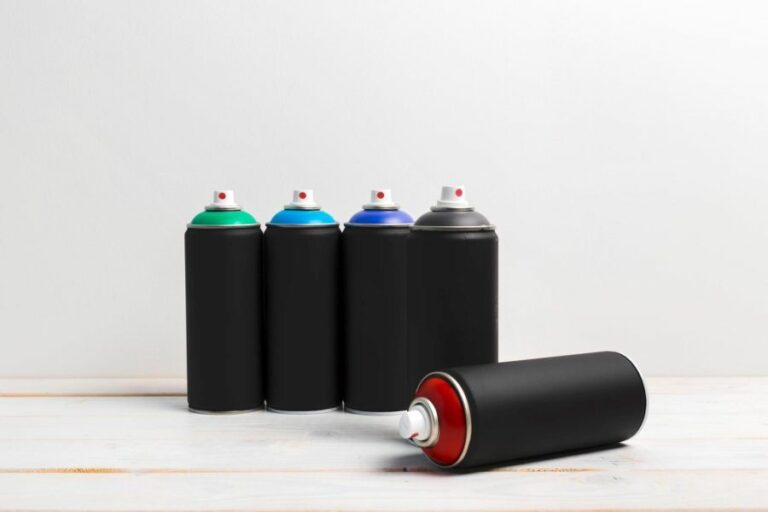Non-Toxic Outdoor Paint, 25 Things You Should Know
Choosing the right paint is crucial as we all want to make our outdoor spaces beautiful and safe for our families, pets, and the environment. I’ve got you covered when it comes to finding the perfect non-toxic outdoor paint that performs well and is also good for the planet.
Non-toxic outdoor paint:
Non-toxic outdoor paint is an eco-friendly alternative to traditional paints containing harmful volatile organic compounds (VOCs). These paints reduce health risks, are better for the environment, and offer improved durability and performance. Available in various colors and finishes, organizations like Green Seal and Greenguard often certify them. Popular brands include AFM Safecoat, ECOS Paints, and BioShield.

Discover the world of non-toxic outdoor paint and its benefits for your home and the environment. With a range of options available, find the perfect eco-friendly solution for your exterior projects. Read on for more information about safe and sustainable choices!
Contents
- 1 Eco-friendly Exterior Paint with Non-toxic Formulation
- 2 Which types of outdoor paint are non-toxic to the environment?
- 3 Examining the Toxicity Levels of Outdoor Paints
- 4 Which Type of Paint is Non-Toxic and Weather Resistant?
- 5 Identifying Non-Toxic Paint Options: A Guide
- 6 Is There an Exterior Paint with Low Volatile Organic Compounds?
- 7 Is Behr Exterior Paint Free from Harmful Toxins?
Eco-friendly Exterior Paint with Non-toxic Formulation
In recent years, there has been a growing awareness about the harmful effects of toxic chemicals found in many paints. These chemicals, known as volatile organic compounds (VOCs), can have negative impacts on our health and the environment.
One solution to this issue is to use non-toxic outdoor paint, which is an eco-friendly option that provides various benefits.
• What are VOCs and Why Should You Be Concerned?
Volatile organic compounds (VOCs) are a group of chemicals that evaporate easily at room temperature. They are found in many paints, sealants, and adhesives. VOCs are known to cause respiratory issues, headaches, and allergic reactions.
In addition to health concerns, VOCs also contribute to air pollution and are a significant factor in the formation of smog.
Furthermore, VOCs can have long-lasting effects on the environment. As they evaporate into the atmosphere, they react with other pollutants to create ground-level ozone, which is harmful to both humans and the ecosystem.
To reduce the negative impacts of VOCs, it is essential to choose non-toxic outdoor paint alternatives.
This EPA webpage provides more in-depth information on the effects of VOCs on indoor air quality and human health.
• Benefits of Non-Toxic Outdoor Paint
There are several advantages to using non-toxic outdoor paint for your home or business. Here are some key benefits:
– Healthier for You and Your Family
By choosing a non-toxic paint, you can reduce the risk of exposure to harmful chemicals that could cause various health issues. These paints are also better for individuals with respiratory problems or allergies, as they do not emit harmful fumes.
– Better for the Environment
Non-toxic outdoor paint is eco-friendly, as it does not release VOCs into the atmosphere. This helps reduce air pollution and contributes positively to overall environmental health.
– Improved Durability and Performance
Many non-toxic outdoor paints have been formulated to provide excellent durability and long-lasting protection for your property. They are resistant to fading, chipping, and other common issues faced with traditional paints.
– Wide Variety of Colors and Finishes
As the demand for non-toxic paints has grown, so too have the options for consumers. Non-toxic outdoor paints are now available in a wide range of colors and finishes, making it easier than ever to find the perfect paint for your project.
• Tips for Choosing a Non-Toxic Outdoor Paint
When shopping for non-toxic outdoor paint, here are some recommendations to help you make an informed decision:
– Check the Label for VOC Content
The easiest way to determine if a paint is non-toxic is to check the label for information on VOC content. Paints with low or zero VOC levels are safer alternatives to traditional paints that contain high levels of these harmful chemicals.
– Look for Third-Party Certifications
Certain organizations, such as Green Seal and Greenguard, provide certifications for non-toxic paints. Products that have been certified by these organizations have met strict standards for low VOC emissions and overall environmental impact.
– Choose Natural or Plant-based Paints
Another option for non-toxic outdoor paint is to choose natural or plant-based products. These paints are made from renewable resources, such as plant oils, and are free of synthetic chemicals and VOCs.
– Consult with Professionals
If you’re unsure about which non-toxic outdoor paint to choose, consult with a professional painter or paint supplier. They can provide guidance on the best products for your specific needs and project requirements.
• A Few Recommended Brands
Here are some well-known and trusted non-toxic outdoor paint brands that you can consider for your next painting project:
- AFM Safecoat: A popular choice for both indoor and outdoor paint, AFM Safecoat offers a range of low-VOC and zero-VOC products that deliver excellent performance.
- ECOS Paints: ECOS is a leading manufacturer of environmentally friendly paint products, including exterior paints with low VOC content and innovative formulations for maximum durability.
- BioShield: Focused on providing natural and eco-friendly paint solutions, BioShield offers a selection of outdoor paints made from plant-based ingredients with no added VOCs or harmful chemicals.
By choosing non-toxic outdoor paint for your home or commercial property, you can create a healthier space, contribute positively to the environment, and enjoy a high-quality paint job that will last for years to come.
Which types of outdoor paint are non-toxic to the environment?
• Identifying Non-Toxic Paints
To ensure safety and sustainability in outdoor environments, opting for non-toxic paint alternatives is essential.
These non-toxic paints are characterized by their low or zero volatile organic compounds (VOC) content. VOCs are harmful chemicals that easily evaporate at room temperature, polluting the air and potentially causing a range of health issues, primarily at high concentrations.
The great news is that numerous manufacturers now produce low-VOC or zero-VOC paint alternatives with minimum environmental and health impact.
– Low-VOC Paint
Low-VOC paints contain reduced amounts of VOCs compared to traditional paints. The exact amount of VOCs may vary between different types and brands of low-VOC paints.
In general, low-VOC paints should have less than 50 grams/liter of VOCs for flat finishes and 150 grams/liter for non-flat finishes. Information on VOC content is typically available on the paint label or the manufacturer’s website.
– Zero-VOC Paint
To be classified as zero-VOC, paint must contain less than 5 grams/liter of VOCs. These paints are the best choice in terms of minimizing environmental and health risks. However, it is important to note that the addition of color can increase the VOC level in some products.
– Natural or Organic Paint
Natural or organic paints often use plant-based binders and pigments, and they generally contain minimal synthetic additives. These paints also tend to emit fewer VOCs than their conventional counterparts.
Some popular natural paint brands incorporate clay, milk, or chalk as essential components of their products.
• Recommendations for Outdoor Non-Toxic Paints
Various non-toxic outdoor paints are suitable for different surfaces and applications. Here, we recommend some excellent alternatives based on their performance and eco-friendliness.
– For Wood Surfaces
1. BioShield Aqua Resin Stain Finish 1
This water-based, zero-VOC stain finish effectively enhances and protects wood surfaces. Made from naturally sourced raw materials like tree resins, it allows the wood’s texture to show through while providing durability and resistance against the elements.
2. Vermont Natural Coatings Exterior Penetrating Wood Stain
Developed using a combination of vegetable oils and whey protein (a natural byproduct of the dairy industry), this exterior wood stain provides a low-VOC and long-lasting finish for wooden surfaces.
It penetrates deeply into the wood, protecting it from moisture and UV rays while allowing the wood grain to show through.
– For Metal Surfaces
1. Ecos Organic Metal Primer
This water-based, low-odor, and low-VOC primer is specifically designed to prepare metal surfaces for top coating with non-toxic paint. It provides excellent adhesion, inhibiting rust and ensuring the paint’s durability.
2. Green Planet Paints Metal
Designed for exterior metal surfaces, Green Planet Paints Metal coatings are zero-VOC, plant-based paints with excellent coverage and durability. These paints are expertly formulated to resist harsh weather conditions and prevent corrosion on metal surfaces.
– For Masonry Surfaces
1. DuraSoke Durable Water Repellent
A water-based, zero-VOC sealer, DuraSoke is an effective and environmentally friendly choice for masonry surfaces. It deeply penetrates into the surface, providing lasting protection against water damage, freeze-thaw damage, and salt intrusion.
2. ROMABIO Mineral Paints
Available in various finishes and colors, ROMABIO mineral paints are ideal for masonry surfaces, including bricks, stucco, and concrete. These zero-VOC mineral-based paints are long-lasting, eco-friendly, and exceptionally resistant to weathering, UV damage, and mold.
• Certifications and Standards
To ensure you are choosing a truly non-toxic outdoor paint, look for products that meet established certifications and standards. Specific certifications like Greenguard Gold, Ecologo, and Green Seal verify that paints have been rigorously tested and have met strict environmental and health criteria.
Furthermore, the U.S. Environmental Protection Agency (EPA) provides guidelines on VOC levels in paints and helps consumers make safe purchases by offering comprehensive information on VOC content and potential health hazards.
• Conclusion
Making a conscious decision to choose non-toxic outdoor paints can significantly impact both your health and the environment. Low-VOC, zero-VOC, and natural paints offer eco-friendly alternatives without compromising on quality and performance.
By selecting such products and adhering to environmental standards and certifications, you can enjoy an aesthetically pleasing and safe outdoor living space.
Examining the Toxicity Levels of Outdoor Paints
• Understanding Outdoor Paints and Their Components
Outdoor paints, also known as exterior paints, are specially formulated to withstand various weather conditions and surface challenges that come with being exposed to external elements.
They often contain three main ingredients: pigments, binders, and solvents. In understanding the toxicity of outdoor paints, one must consider each of these components.
– Pigments
Pigments are responsible for the paint’s color and opacity. Commonly used inorganic pigments in outdoor paints include titanium dioxide, iron oxide, and zinc oxide. These are considered non-toxic and safe for outdoor use.
However, some pigments may contain trace amounts of heavy metals, such as lead and chromium, which can be harmful if ingested or inhaled in significant quantities.
– Binders
Binders are the glue that holds the paint together and attaches it to surfaces. They determine the paint’s durability, adhesion, and resistance to weather conditions. Binders for outdoor paints are typically made from acrylic, latex, and oil-based resins.
Most modern binders are formulated to be safe and non-toxic, although some oil-based paints may contain trace amounts of hazardous volatile organic compounds (VOCs).
– Solvents
Solvents serve to control the consistency of the paint and help it dry faster. Water is the most common solvent in latex and acrylic paints, while oil-based paints often use mineral spirits or other petroleum-based solvents.
High VOC solvents can evaporate from outdoor paints as they dry, releasing potentially harmful gases into the air.
• The Potential Toxicity of Outdoor Paints
The primary concern surrounding outdoor paint toxicity relates to the presence of VOCs. VOCs are organic compounds that can easily evaporate at room temperature and release hazardous gases, contributing to air pollution and potential health problems.
– Health Risks Associated with VOCs
Exposure to high concentrations of VOCs can lead to potential health issues such as irritation of the eyes, nose, and throat, difficulty breathing, headaches, and dizziness.
Prolonged exposure to high levels of VOCs has been linked to kidney and liver damage, as well as potential harm to the central nervous system.
– Environmental Impact of VOCs
VOCs contribute to the formation of ground-level ozone, which is a significant component of smog. Ozone is a lung irritant that can exacerbate respiratory illnesses, particularly for those with pre-existing conditions like asthma.
Additionally, some VOCs can contribute to climate change by acting as greenhouse gases.
• Regulations and Recommendations for Safer Outdoor Paints
To address the concerns surrounding the toxicity of outdoor paints, governments and regulatory bodies have taken measures to reduce the presence of harmful components in paint formulations.
– VOC Regulations
In the United States, the Environmental Protection Agency (EPA) regulates the VOC content in paints and coatings to reduce air pollution levels. The limits vary depending on the type of paint and its intended application.
These regulations have led to the development of low-VOC and zero-VOC paint formulations, which have become increasingly popular options for both indoor and outdoor applications.
– Lead-Free Paints
Lead was once a common component in both indoor and outdoor paints, but its use has been significantly restricted in many countries, including the United States.
The U.S. Consumer Product Safety Commission banned the use of lead in household paints in 1978, effectively removing it from the market as a component in both interior and exterior paint formulations.
• Recommendations for Safer Outdoor Painting Practices
To minimize potential risks associated with toxic outdoor paints, consider the following recommendations:
- Choose low-VOC or zero-VOC paints: Look for outdoor paint formulations that specifically mention low-VOC or zero-VOC content on the label. These options are less likely to contain harmful components and pose less risk to health and the environment.
- Proper ventilation: When applying outdoor paints, ensure proper ventilation and avoid working in confined spaces. This will help reduce the buildup of harmful fumes and minimize the risk of respiratory irritation.
- Use caution with older surfaces: Old paint layers on surfaces may contain lead or other harmful components. When preparing surfaces for repainting, take care not to disturb or ingest paint dust, and consider hiring a professional if you suspect the presence of lead-based paint.
- Dispose of paint responsibly: Follow local regulations for the proper disposal of unused or leftover paint. Many communities offer designated paint recycling or hazardous waste disposal facilities to prevent potential environmental contamination.
In conclusion, modern outdoor paints have come a long way in terms of reducing their potential toxicity. By choosing safer, low-VOC formulations and adhering to proper painting practices, individuals can minimize their exposure to harmful components while enjoying beautiful, durable outdoor paint finishes.
Which Type of Paint is Non-Toxic and Weather Resistant?
As a professional with years of experience in the paint industry, I understand the importance of using non-toxic and weather-resistant paint for both indoor and outdoor applications.
• What Makes a Paint Non-Toxic?
Non-toxic paints are those that are free from harmful chemicals and substances, making them safe for the user and the environment.
These paints typically contain low to zero volatile organic compounds (VOCs), which are known for causing headaches, and dizziness and can even contribute to long-term health issues.
In addition, many non-toxic paints are made without solvents, as some solvents are harmful to humans and can release hazardous air pollutants.
• Why Choose Weather Resistant Paint?
Weather-resistant paint helps protect surfaces from various weather conditions, such as rain, wind, and UV radiation. This type of paint is especially beneficial for outdoor applications, as it can prevent damage and prolong the life of surfaces like wood, metal, and masonry.
Furthermore, investing in weather-resistant paint can save you time and money in the long run, as it generally requires less maintenance and repaints.
• Water-Based Acrylic Paints: A Non-Toxic and Weather-Resistant Option
One popular option for non-toxic and weather-resistant paint is water-based acrylic paint. These paints are known for being long-lasting, resistant to fading, and low in VOCs. They also provide excellent adhesion to various surfaces and can be cleaned up easily using only water.
– Benefits of Water-Based Acrylic Paints
- Low VOC content, making them environmentally friendly and safe for users
- Excellent adhesion to a variety of surfaces, including wood, metal, and masonry
- Highly resistant to fading, chalking, and mildew growth
- Easy to clean up with water, avoiding the need for harmful solvents
- Weather resistant, protecting surfaces from rain, wind, and UV exposure
• Helpful Tips for Applying Non-Toxic Weather Resistant Paint
- Properly clean and prepare the surface before painting. Remove any loose or peeling paint, dirt, mildew, and debris using a wire brush, sandpaper, or power washer. Thoroughly clean the surface with a mild detergent and water, then allow it to dry completely.
- Prime the surface, especially if it is porous, stained, or has never been painted before. This helps ensure a smooth, even finish and better adhesion of your non-toxic weather-resistant paint.
- Choose high-quality brushes and rollers for optimal paint application. Synthetic brushes work best with water-based acrylic paints.
- Apply thin, even coats of paint. Depending on the surface and color, you may need two or more coats for adequate coverage.
- Allow sufficient drying time between coats, typically at least 2 hours for water-based acrylic paints. Check the paint manufacturer’s instructions for specific drying times.
- Protect your paint job by applying a non-toxic, weather-resistant sealer or topcoat.
• Recommended Non-Toxic Weather Resistant Paints
Some highly recommended non-toxic weather-resistant paints include:
- AFM Safecoat AquaCote: A zero-VOC, water-based acrylic paint suitable for interior and exterior use. It is durable, long-lasting, and has excellent resistance to fading and mildew growth. (Available at AFM Safecoat)
- Ecos Paints Exterior Wall Paint: A zero-VOC, water-based acrylic paint that is exceptionally durable and formulated for superior weather resistance. It has outstanding adhesion and can be used on various exterior surfaces. (Available at Ecos Paint)
- Sherwin-Williams Duration Exterior Paint: A low-VOC, water-based acrylic paint with advanced UV protection, making it perfect for outdoor use. It is also self-priming and resistant to mildew growth. (Available at Sherwin-Williams)
• Conclusion
Choosing a non-toxic, weather-resistant paint is a smart investment for the health of you, your family, and the longevity of your painting project. Water-based acrylic paints are an excellent option, providing durability and safety without compromising performance.
By properly preparing the surface, using quality tools, and following the tips and recommendations shared in this article, you can achieve a stunning and long-lasting paint job.
Identifying Non-Toxic Paint Options: A Guide
Let’s delve into the world of non-toxic paint, explaining how to identify the different types available and offering recommendations for those looking to make a safe and environmentally-conscious decision in their next painting project.
• Understanding Paint VOCs
To better understand non-toxic paint, it’s important first to discuss “VOCs,” or volatile organic compounds. VOCs are chemicals commonly found in paints, solvents, and other coatings that can evaporate into the air and contribute to smog, respiratory issues, and other health concerns.
Many governments have taken measures to reduce the use of high-VOC or toxic paint, but it can still be found in some products. When embarking on any painting endeavor, it’s essential to find products with lower VOCs to limit exposure and make a healthier choice for you and the environment.
The U.S. Environmental Protection Agency (EPA) offers further information on its official website to better understand the impact of VOCs on indoor air quality and health.
• Zero VOC Vs. Low VOC Paint Options
There are essentially two categories of non-toxic paint: zero VOC paint and low VOC paint. Here’s a closer look at each:
– Zero VOC Paint
As the name suggests, zero VOC paint contains no volatile organic compounds. This type of paint can significantly help minimize indoor air pollution and protect the health of people living or working in the building.
One caveat is that some zero VOC paints might still contain trace amounts of VOCs (less than 5 grams per liter), which is generally considered negligible.
– Low VOC Paint
Low VOC paint, on the other hand, contains reduced levels of volatile organic compounds compared to traditional paint. While it isn’t entirely free of VOCs, it is still a much healthier option than conventional high-VOC paint options.
The EPA guidelines typically define low VOC paint as having fewer than 50 grams per liter of VOCs.
When choosing between zero VOC and low VOC paint, it’s important to weigh the specific needs of your project and your specific health concerns.
Zero VOC paint is the safest option, but low VOC paint can also be a reasonable choice for those prioritizing reduced emissions without needing to eliminate them entirely.
• Natural Paint: A Sustainable Alternative
Natural paints, as the name implies, are made using naturally occurring materials, such as plant oils, mineral pigments, and resins. These paints are free from synthetic chemicals, making them a more sustainable and eco-friendly option.
Some popular types of natural paint include:
– Clay Paint
This paint is made from clay, water, and natural pigments. It is environmentally friendly and offers an earthy, textured finish. Clay paint is ideal for interior walls and can help regulate humidity due to its natural properties.
– Lime Paint
Derived from limestone, lime paint provides a breathable, textured finish for walls and ceilings. Its naturally high pH level means it’s also resistant to mold and mildew. Lime paint is well-suited for traditional or historic buildings due to its compatibility with older building materials.
– Milk Paint
Made from milk protein, lime, and pigment, milk paint offers a traditional finish reminiscent of historic homes. It is entirely organic, biodegradable, and durable. Milk paint can be used on walls, furniture, and other surfaces.
• Recommendations for Non-Toxic Paint Brands
Here are some trusted paint brands which offer zero VOC or low VOC alternatives, as well as natural paint options:
- Benjamin Moore: Offers the Natura line, a zero VOC paint option available in various colors and finishes.
- Sherwin-Williams: Provides the Harmony line, a zero VOC line with odor-eliminating technology, ideal for interior walls.
- ECOS Paints: Specializes in zero VOC paint and natural finishes, including wood stains and varnishes.
- BioShield Paint: Offers a range of natural paint options, including clay and lime paint, as well as low VOC wall paint.
• Conclusion
Choosing non-toxic paint is an essential step towards creating a healthier environment for our homes and workplaces, as well as ensuring a more sustainable future for our planet.
By selecting zero VOC, low VOC, or natural paint options, we can make informed choices that prioritize our well-being and minimize our impact on the environment. It’s a win-win for everyone involved.
Is There an Exterior Paint with Low Volatile Organic Compounds?
The answer to this question is a resounding yes. Low VOC (Volatile Organic Compounds) exterior paints are not only available in the market but have been increasingly gaining prominence in recent years.
The popularity of these paints has surged owing to their reduced environmental impact and improved safety standards.
• Understanding Low VOC Paints
VOCs are chemical compounds that vaporize into the atmosphere at room temperature. Traditional paints typically contain a high concentration of these compounds, which can cause environmental pollution and health-related issues like eye and throat irritation, allergies, and even more severe problems for sensitive groups like children, the elderly, and those with respiratory conditions.
Low VOC paints, on the other hand, are formulated with a reduced amount of volatile organic compounds. These eco-friendly alternatives emit fewer harmful chemicals during the painting process and significantly reduce the overall pollution levels associated with paint applications.
– Benefits of Low VOC Exterior Paints
There are several advantages to opting for low-VOC exterior paints over conventional alternatives. Let us explore some of the key benefits of these products.
Environmental Benefits
By using low-VOC exterior paints, you dramatically decrease the emission of toxic pollutants. This helps in preserving air quality and reducing the paint industry’s carbon footprint.
Health Benefits
Although exterior paints do not directly contribute to indoor air pollution, they are used on surfaces exposed to sunlight, rain, and other environmental factors. Therefore, using low-VOC exterior paints significantly reduces the risk of potential health issues arising from exposure to these pollutants.
Compliance with Regulations
Increasingly stricter environmental regulations, such as LEED (Leadership in Energy and Environmental Design), mandate the use of low-VOC exterior paints for residential and commercial projects.
By choosing low VOC options, homeowners and professionals can ensure compliance with these regulations and contribute to greener construction practices.
– Low VOC Exterior Paint Brands and Options
There is an increasing range of low VOC exterior paint options available in the market today, catering to various preferences and budgets. Some of the most popular and reliable low-VOC exterior paint brands include:
- Sherwin-Williams’ Duration and Emerald lines
- Benjamin Moore’s Aura and Regal Select lines
- PPG Paints’ Pure Performance and Speedhide lines
- Behr’s Marquee and Premium Plus lines
It is recommended that when choosing a low VOC exterior paint, you look for products displaying the GREENGUARD or Green Seal certification, which signifies that the paint meets stringent low VOC and environmental standards.
– Performance of Low VOC Exterior Paints
One of the main concerns people have when considering low-VOC exterior paints is whether they perform as well as their traditional counterparts. The good news is that advancements in paint technology have ensured that low-VOC exterior paints do not compromise on quality or durability.
In fact, many low-VOC exterior paints available today offer excellent weather resistance, UV protection, and color retention. They are also easier to clean and maintain, making them a great investment for the exterior of your home.
– Tips for Preparing and Painting with Low VOC Exterior Paints
Here are some practical tips for using low-VOC exterior paints that will ensure a successful and long-lasting paint job:
- Proper Surface Preparation: Clean the surface to be painted thoroughly, removing any dirt, excess chalk, and loose or peeling paint. Use a pressure washer or a brush with a mixture of water and mild detergent to achieve the best results.
- Priming: Use a suitable low VOC primer to ensure proper paint adhesion and longevity. A good primer will also prevent stains from bleeding through and provide a uniform finish.
- Application: Carefully follow the manufacturer’s instructions for the chosen paint, such as recommended temperature, humidity levels, and drying times. Apply at least two coats of paint for a durable and long-lasting finish.
• Conclusion
Low VOC exterior paints are an excellent choice for homeowners and professionals looking to prioritize environmental and health concerns without compromising on quality and performance.
With a growing range of products available in the market, now is a great time to make the switch and experience the numerous benefits these eco-friendly alternatives have to offer.
Is Behr Exterior Paint Free from Harmful Toxins?
As a professional who’s been working within the painting industry for years, I’ve come across a variety of paint brands and products. Among them, Behr has made a significant impression on both professionals and homeowners alike.
• Overview of Behr Exterior Paints
Behr is a well-established and reputable paint manufacturer known for producing high-quality, reliable, and durable paints for both residential and commercial applications. They offer a variety of exterior paint products, each designed to meet specific needs and preferences.
Among their most popular lines are Behr Premium Plus Ultra, Behr Marquee, and Behr Deckover.
– The Importance of Low VOCs and Non-toxicity
Paints can contain volatile organic compounds (VOCs), which become air pollutants as they evaporate. These compounds can have negative effects on air quality, human health, and the environment.
Choosing paint with low VOCs can significantly reduce these potential hazards, making it safer for both the occupants of the painted space and the surrounding environment.
• Environmental Regulations and Certifications
With increasingly stringent environmental regulations and consumer demand for environmentally friendly paint products, manufacturers like Behr have been making efforts to reduce the environmental impact of their products. I
n this section, we’ll look at how Behr’s exterior paints measure up in terms of meeting safety and environmental standards.
– Greenguard Certification
The majority of Behr’s exterior paints have earned the Greenguard Gold certification, which signifies that they meet stringent standards for low VOC emissions.
Greenguard Gold, a certification provided by the industry-respected organization UL, ensures that a product contributes to a healthier indoor environment (source). Earning this certification demonstrates Behr’s commitment to providing non-toxic, environmentally friendly paint products.
– Regulation Compliance
Behr’s exterior paints meet various environmental regulations across the United States, ensuring that their products are safe to use by both professionals and homeowners.
Some states have specific regulations limiting the use of certain harmful chemicals and VOCs in paint products, and Behr’s low-VOC exterior paints comply with these requirements.
• Personal Recommendations from Experience
Having worked extensively with Behr’s exterior paint products, I can confidently recommend them for their quality, durability, and low environmental impact. Some stand-out products include:
– Behr Premium Plus Ultra
This paint and primer in one is ideal for those looking for a durable, high-performing product. Its low VOC formulation reduces harmful emissions while providing excellent coverage and long-lasting protection. I highly recommend this for both residential and commercial applications.
– Behr Marquee
As Behr’s top-of-the-line exterior paint, Marquee offers one-coat coverage and a lifetime guarantee. Its advanced formulation provides excellent adhesion, durability, and protection against the elements. If you’re looking for a premium option that will stand the test of time, this is my go-to choice.
– Behr Deckover
Designed specifically for exterior wood and concrete surfaces, Deckover provides a thick, durable coating that helps revitalize and protect your deck, patio, or walkway. Its non-toxic formula ensures that your outdoor spaces remain safe and healthy while looking great.
• Conclusion
In conclusion, Behr’s exterior paint products are indeed non-toxic, with low VOC formulations that meet stringent environmental standards and certifications.
In my professional experience, these paints not only provide excellent performance and durability but also contribute positively to the environment and indoor air quality.
I wholeheartedly recommend Behr exterior paints for your next project, knowing you’ll be making a safe and environmentally responsible choice.







